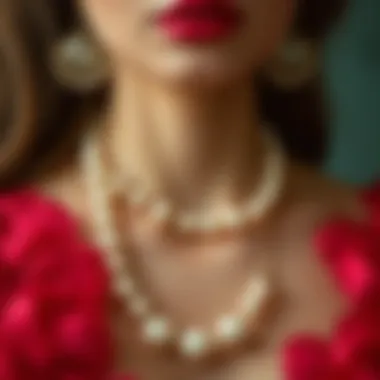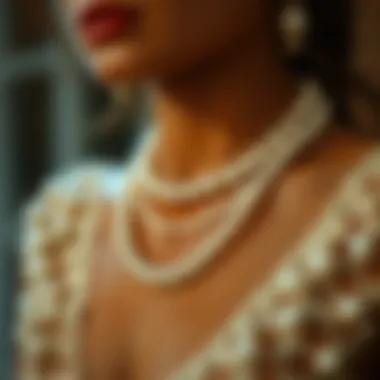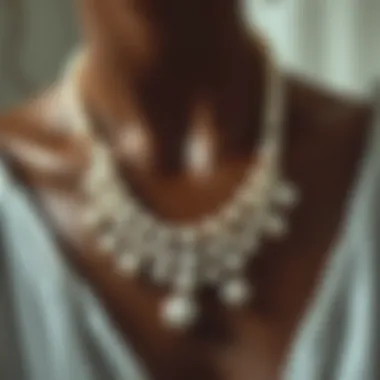Crafting Elegance: The DIY Pearl Necklace Kit Guide


Intro
Pearl necklaces hold a unique place in the world of fashion and personal adornment, combining elegance and versatility in ways that few other accessories can. The allure of pearls has spanned cultures and centuries, from the opulent styles of ancient royalty to the modern-day minimalist approach to jewelry. This article breaks down the process of creating your own pearl necklace through DIY kits, uncovering the essential elements needed for crafting and the artistic potential that comes with it.
Crafting jewelry provides not just a creative outlet but also a deeper understanding of the materials we wear. With DIY pearl necklace kits making waves in the fashion community, individuals can tap into their personal style and showcase creativity. From understanding different types of pearls to the tools necessary for assembly, this guide equips readers with a comprehensive overview, ensuring a fulfilling crafting journey.
Clothing Trends Analysis
In considering the significance of DIY pearl necklace kits, it’s vital to appreciate the broader context of fashion trends that they fit within.
Current Trends in Seasonal Fashion
Pearls are making a comeback, surfacing as a hot commodity in today’s seasonal fashion. The movement towards sustainable and personalized fashion choices has encouraged the popularity of DIY kits. As more individuals lean towards unique expressions of self, pearl necklaces become a prevalent option, blending contemporary designs with classic aesthetics. Current trends reflect an inclination towards accessorizing with statement pieces and layering varied lengths of necklaces for added texture and character.
Iconic Styles Through Decades
- 1920s and 30s: The flapper era embraced long strands of pearls that hung like cascades, often paired with simple dresses to create dramatic effects.
- 1950s: Pearls epitomized sophistication, famously worn by icons like Audrey Hepburn, showcasing their timeless appeal.
- 1990s: Layering became the fashion mantra, as chokers and layered pearl strands found their place among grunge styles.
- 2020s: The current decade sees a fusion of all these styles, where DIY kits allow for mixing contemporary flair with vintage charm.
Foreword to DIY Pearl Necklace Kits
In recent years, the allure of DIY pearl necklace kits has captured the attention of many fashion enthusiasts, offering a unique blend of creativity and personal expression. These kits not only empower individuals to craft their jewelry, but they also provide an opportunity to delve into the world of pearls, a material steeped in history and elegance. Embracing the DIY approach allows designers and hobbyists to engage directly with the process of creation, fostering a deeper connection to their finished pieces. Plus, it’s an engaging way to appreciate the nuances of jewelry making.
Understanding the Appeal of DIY Jewelry
The charm of DIY jewelry lies in its ability to transform simple materials into something meaningful and personal. Many people turn to jewelry making as a way to unwind and tap into their artistic side. Crafting a pearl necklace is not merely about creating an accessory; it’s about the journey of creativity, from selecting materials to the final assembly. Each step offers a chance to explore personal style and design preferences.
For many, the satisfaction derived from creating something with their own hands is unparalleled. A DIY pearl necklace can serve as a heartfelt gift or a statement piece that resonates with the wearer’s identity. The appeal also extends to sustainability, as people become more conscious of their consumer choices. By making their jewelry, they can choose ethically sourced materials and reduce waste, giving them greater control over the environmental impact of their creations.
Overview of the DIY Pearl Necklace Kit
A typical DIY pearl necklace kit comes equipped with all the essentials needed to create a personalized piece of jewelry. These kits are designed for various skill levels, making them accessible for both beginners and experienced crafters alike. Generally, you can find a variety of components within these kits:
- Different Types of Pearls: Ranging from lustrous natural pearls to carefully cultivated options and even imitation varieties, the choice of pearls can significantly influence the final look of the necklace.
- Strings and Threads: Most kits include high-quality threads suitable for stringing pearls, ensuring durability and beautiful finish.
- Clasp Mechanisms: The clasp is the unsung hero in a necklace design. Kits typically feature different clasp options, allowing users to select one that complements their work.
- Beading Needles: Often included in the kits, these needles are essential for threading the pearls onto the string with precision.
A DIY pearl necklace kit is more than just a collection of materials; it encapsulates an entire creative process, inviting wearers to immerse themselves in the art of jewelry making. With each kit, one embarks on a journey that not only showcases their craftsmanship but also tells a story through each bead strung together. Whether for personal wear or as a gift, the resulting piece carries with it a sense of accomplishment and pride.
Components of a DIY Pearl Necklace Kit
When embarking on the journey of crafting your own pearl necklace, understanding the components of a DIY pearl necklace kit is essential. These kits not only provide the materials but also serve as a valuable guide to help you navigate through the intricate process of making beautiful jewelry. Each element contributes to the overall experience, enabling creativity and personal expression while ensuring a quality final product.
Types of Pearls Offered in Kits
Natural Pearls
Natural pearls form through a process that occurs in the wild, where an oyster secretes layers of nacre around an irritant. They are often highly prized not just for their beauty, but for their rarity. One significant advantage of natural pearls is their unique luster and organic character; no two are exactly alike. This uniqueness can make a necklace created with them feel more personal and special.
However, natural pearls can come with a hefty price tag, making them a less accessible choice for beginner crafters or those not looking to invest heavily. The focus on authenticity and sustainability, however, often draws individuals toward these pearls despite the cost.
Cultured Pearls
Cultured pearls are produced under controlled conditions, where humans introduce an irritant into an oyster. This method significantly increases the availability of pearls, making them more affordable compared to their natural counterparts. The consistent quality of cultured pearls makes them a popular choice for DIY kits. They come in various colors, sizes, and shapes, allowing crafters to choose according to their design preferences.
One draw back is that some purists might argue cultured pearls lack the charm of natural ones, but for most DIY enthusiasts, the ability to choose from a variety of options is a substantial benefit.
Imitation Pearls


Imitation (or faux) pearls are created using materials like glass or plastic, designed to mimic the appearance of real pearls. They offer an economical alternative in DIY kits, making jewelry-making accessible to a broader audience. These pearls can be quite convincing in terms of appearance, allowing crafters to create visually stunning pieces without breaking the bank.
While imitation pearls may not carry the same prestige or long-term value as natural or cultured pearls, they often come in vibrant colors and various styles, which can be exciting for creative designs. This versatility can serve the needs of designers and hobbyists looking to experiment without the weight of high expense.
Necessary Tools and Materials
However, a pearl necklace kit isn't just about the pearls themselves; there are key tools and materials that ensure the crafting process runs smoothly.
Strings and Threads
Strings and threads are the backbone of any pearl necklace. The right string is crucial for not only aesthetic appeal but also durability. Nylon and silk threads are popular choices due to their strength and flexibility. This flexibility makes it easier to knot your pearls securely and helps maintain the elegance of the final product.
The downside? Strings can fray, especially if not handled with care. Finding the balance between strength and appearance is essential, and choosing the right thread can elevate the entire design.
Clasp Mechanisms
Clasp mechanisms are vital for securing your completed necklace. From lobster clasps to magnetic closures, the choice can affect not only how easy it is to put the necklace on and take it off but also the overall aesthetic. A well-chosen clasp can complement the pearls beautifully and can even serve as a design feature itself.
On the flip side, some claps can wear down over time, potentially leading to a loss of the necklace. Therefore, durability should be a consideration when selecting the clasp type for your project.
Beading Needles
Beading needles might appear simple, but they play a crucial role in the assembly process. These needles are specially designed with a small eye, perfect for threading thin threads through pearl holes without damaging them. Using the right beading needles can make the process smoother and more enjoyable.
However, one must be cautious, as beading needles can be quite fragile. Using too much force can cause them to bend or break, so patience and a gentle touch are key.
Crafting Your Pearl Necklace
Crafting your pearl necklace is not just about stringing pearls together; it’s an opportunity to express creativity and make a personal statement. Each pearl you choose can reflect your style, while the way you design and assemble the necklace reveals your craftsmanship. It allows you to create pieces that resonate with your personality or can serve as thoughtful gifts for others. Taking the time to design and assemble your unique necklace nurtures a sense of achievement and connection to the art of jewelry making.
Designing Your Necklace
Designing is a crucial element of crafting a pearl necklace. It encases the aesthetic, emotional, and personal elements that tie the piece together.
Choosing Color Schemes
When it comes to choosing color schemes, one must consider the emotional tone and visual impact the necklace will evoke. Color schemes can bring life to your design as they can evoke different moods. A monochromatic scheme using shades of a single color can create elegance, while a complementary scheme involving contrasting colors can provide vivacity.
- Key Characteristic: It harmonizes the elements of your design, ensuring a cohesive look.
- Why It’s Beneficial: A well-thought-out color scheme adds depth to your piece, making it appealing for various occasions.
- Unique Feature: Color schemes facilitate personalization. Whether you prefer pastel hues for a soft look or bold colors for a statement piece, the choice is yours.
However, it's crucial to ensure that the selected colors suit the pearls’ natural luster; some colors might overshadow the pearls’ beauty rather than enhance it.
Arranging Patterns
Arranging patterns is where creativity truly shines. This step involves determining how to space and position your pearls for visual interest. Whether your choice leads you to a symmetrical arrangement or a more freeform style, the visual balance is paramount.
- Key Characteristic: Arranging pearls in a thoughtful pattern can draw the eye effectively along the necklace.
- Why It’s Popular: Patterns enhance visual storytelling, revealing movement and flow through your piece.
- Unique Feature: Different patterns can invoke varying styles, from classic to contemporary. A classic alternating pattern may speak to tradition, while an asymmetrical design might say daring and modern.
Nonetheless, a chaotic arrangement can undermine the necklace's overall appeal, so it’s essential to strike a balance that feels right.
Incorporating Other Elements
Incorporating other elements into your necklace can elevate its complexity and personal flair. This can include adding charms, pendants, or even using mixed materials like leather or metal.
- Key Characteristic: It allows for the introduction of various textures that can enhance visual appeal.
- Why It’s Beneficial: By integrating unique elements, you introduce layers of meaning or personal identity into your jewelry.
- Unique Feature: It grants you the license to think outside the box; charm bracelets or gemstone accents can be an exciting twist.


While adding elements enriches your design, be cautious as too many embellishments may detract from the pearls' elegance.
Step-by-Step Assembly Process
Once the design phase is clear, moving on to the assembly process is next. This step transforms your vision into a tangible piece, requiring patience and precision.
Preparing the Necklace Base
In preparing the necklace base, you set the stage for your entire creation. Selecting the right type of string or thread is paramount, as it holds everything together.
- Key Characteristic: The base must be durable enough to withstand wear while maintaining a fluid aesthetic.
- Why It’s Popular: A strong base provides reliability to the overall structure of your necklace.
- Unique Feature: Different materials offer diverse visual outcomes; silk thread may provide a classic look, while nylon might offer robustness.
Remember, a weak base can lead to a disappointing wearing experience, as your necklace may not hold up over time.
Stringing the Pearls
Stringing the pearls is where the magic begins. It requires both skill and attention to detail to ensure that each pearl sits precisely how it was envisioned.
- Key Characteristic: The order of stringing is vital; thus, following your design layout closely is crucial.
- Why It’s Beneficial: Proper stringing prevents tangling and allows for smooth movement when wearing the necklace.
- Unique Feature: This is where your pattern comes to life; seeing the arrangement materialize can be quite rewarding.
However, a hasty stringing might lead to errors that ruin the design and fit, speaking to the value of patience in this process.
Securing the Clasp
Finally, securing the clasp completes your pearl necklace. This seemingly simple step is critical, as it ensures that the necklace remains intact when worn.
- Key Characteristic: A secure clasp allows the wearer to put on or take off the necklace easily.
- Why It’s Beneficial: A clasp that complements your design can enhance the overall beauty of the necklace.
- Unique Feature: Different clasps, from lobster claws to magnetic ones, can bring a modern twist to a classic piece.
Yet, it’s important that the clasp does not overwhelm the pearls; a mismatch can detract from the overall elegance you aim to achieve.
Tips for a Successful DIY Project
Embarking on a DIY pearl necklace project can be an enjoyable yet challenging experience. This section focuses on essential strategies that can pave the way for a successful endeavor. From choosing the right tools to enhancing the overall aesthetics of your creation, it’s crucial to keep certain tips in mind. Not only do these shortcuts save you from potential pitfalls, but they also enhance the joy derived from crafting jewelry. Considerations such as handling common challenges, ensuring visual harmony, and making thoughtful selections can elevate your project from merely functional to truly stunning.
Common Challenges and Solutions
Every craft has its quirks, and DIY jewelry-making is no exception. Identifying potential challenges and knowing how to tackle them can transform your crafting experience.
Dealing with Tangled Threads
Tangled threads can drive any DIY enthusiast up the wall. This issue arises often during the stringing process of your pearls. A key characteristic of tangled threads is their ability to disrupt the fluidity of your work, causing delays and frustration. One recommended solution is to keep your working area organized. Using a dedicated spool holder can prevent the thread from unwinding too freely, which is a popular tip among seasoned crafter. Some even swear by dividing long threads into shorter lengths, which can be less prone to tangling.
Ensuring Even Spacing of Pearls
Ensuring even spacing of pearls is vital for achieving a polished look. Uneven spacing can make your necklace appear haphazard, which detracts from the overall aesthetic. A bench tester might suggest using spacers, which help maintain consistent intervals between pearls. This way, not only does your necklace look professional, but it also gives a sense of balance that's pleasing to the eye. However, bear in mind that the use of spacers can sometimes restrict your design flexibility.
Choosing the Right Clasp Type
The clasp you select can play a surprisingly significant role in both functionality and style. A good clasp ensures that your necklace not only stays securely in place but also complements its aesthetic appeal. Lobster clasps and toggle clasps are two commonly favored options. Lobster clasps are known for their security, while toggle clasps offer a more artistic look. Choosing a clasp should take into consideration the weight of the pearls; heavier designs might require sturdier clasps to withstand wear.
Enhancing Aesthetic Appeal
Once the functional components of your necklace are in place, you can turn your attention to aesthetic enhancements. This part is vital as it allows for personal expression and creativity within your jewelry-making.
Adding Charms or Pendants


Incorporating charms or pendants can elevate the appeal of your pearl necklace. They offer a unique twist that can symbolize personal stories or experiences. This approach allows the maker to infuse individuality into their creation, making it a conversation starter. However, careful consideration should be given to the size and design of the added elements, as overly large charms could overshadow the elegance of the pearls.
Integrating Different Strands
Integrating different strands of pearls or other beads can create a rich tapestry in your jewelry piece. This technique allows for more complex designs and can introduce various colors and materials to your piece. It can be a beneficial approach if done tastefully, but too many strands can lead to a cluttered appearance. It’s key to strike a balance; fewer but well-curated strands often yield a more sophisticated design.
Choosing Complementary Accessories
Lastly, the choice of complementary accessories can tie the whole look together. Selecting earrings or bracelets that also feature pearls or colors that harmonize can complete your ensemble beautifully. Consider the occasion and the personal style of the wearer when making these choices. Accessories that echo the colors or themes of your necklace can create a cohesive look, elevating your overall presentation.
"Details make the design—every choice you make reflects your unique style."
By considering these tips, you're setting yourself up for a successful and enjoyable DIY pearl necklace project. Balanced attention to both functionality and aesthetics will ensure your creation is not just an accessory but a statement piece.
The Cultural Significance of Pearl Jewelry
Pearl jewelry holds a significant place in many cultures and historical contexts, transcending mere aesthetics to embody deeper meanings and values. In exploring DIY pearl necklace kits, it's essential to understand the cultural implications of wearing pearls. From ancient history to modern fashion, pearls have been more than just accessories; they represent status, purity, and expression of individuality. Engaging with the craftsmanship involved in creating pearl jewelry allows individuals to connect with this rich tapestry of cultural significance, emphasizing the deeper understanding of beauty and artistry.
Historical Context of Pearls
Throughout history, pearls have been treasured by various civilizations. Ancient Romans believed pearls were the tears of the gods, while in China, they were associated with wisdom and purity. As trade routes expanded, pearls became a symbol of wealth and sophistication across Europe and Asia, often reserved for royals and the elite. In the early 20th century, a shift occurred as cultured pearls were developed, making them more accessible to the average consumer.
This democratization led to a surge in popularity, establishing pearls not only as luxury items but also as symbols of refined taste. The evolution of these pearls from luxury to accessible pieces showcases a fascinating intersection between craftsmanship and cultural evolution, melding art with societal change. Understanding this history enriches the experience of crafting one’s own pearl jewelry, as it places the maker in a lineage of craftspeople who have upheld this tradition.
Symbolism in Various Cultures
Pearls carry rich symbolism across different cultures, making them more than just beautiful gemstones. Their meanings often reflect the values and beliefs of the societies that revere them. Among the most prominent themes are purity, innocence, loyalty, and wealth.
Purity and Innocence
The concept of purity is deeply ingrained in the symbolism of pearls. In many cultures, their natural luster and unblemished surfaces are seen as representations of innocence. This aspect plays a key role, particularly in celebrations like weddings, where pearls often adorn brides, symbolizing a pure beginning. The association of pearls with virginity and chastity over centuries has made them a favored choice for important life events.
A unique feature of this symbolism is its universality; across cultures, pearls are embraced for their classic beauty and the metaphor they embody. However, this can also present challenges, as some cultures may view the over-commercialization of pearls as undermining their traditional significance.
Loyalty and Wealth
In addition to purity, pearls symbolize loyalty and wealth. Historically, owning pearls signified affluence, as they were rare and difficult to obtain. Kings and queens adorned themselves with pearl jewelry to showcase their power and influence. As symbols of loyalty, pearls have often been gifted between partners or spouses, representing lasting devotion and honor.
This duality of loyalty and wealth contributes heavily to their desirability today, especially in the context of fashion and personal expression. By incorporating pearls into DIY projects, individuals can manifest these attributes in a uniquely personal way, creating pieces that not only reflect their style but also align with these rich meanings.
The allure of pearl jewelry is not just its beauty but its deep-rooted cultural significance, allowing wearers and crafters alike to touch upon centuries of artistry and symbolism.
Epilogue
The journey of crafting a DIY pearl necklace extends far beyond simply stringing a few beads together. It symbolizes an intersection of personal artistry and cultural narratives that has persisted through the ages. This article highlighted the various elements of DIY pearl necklaces, presenting a clear view of the benefits and considerations that come into play when engaging in this creative process.
Reflecting on Personal Craftsmanship
Personal craftsmanship in jewelry making is akin to a dance between skill and imagination. Whenever someone decides to create a piece, they weave personal stories, emotions, and influences into every strand. This activity encourages not just a connection with the medium, but also a deeper understanding of one's own preferences and style. When you sit with a kit in hand, preparing to shape your creation, it becomes an extension of yourself—something uniquely yours.
Incorporating DIY Pearls into Personal Style
Integrating DIY pearl necklaces into your personal fashion has transformative effects. They can elevate simple outfits, add a touch of elegance, or even reflect one's mood. The versatility offered by handmade pieces cannot be overstated.
Creating Unique Gifts
Crafting a pearl necklace as a gift holds a distinctive charm. It showcases thoughtfulness and effort, qualities that store-bought items often lack. A piece tailored specifically for someone demonstrates not just the giver’s creativity but also their understanding of the recipient's tastes. Moreover, these gifts carry a story—a memory embedded within knots and pearls, making them far more special than standard retail options. They are a popular choice among friends and family, appealing to those who appreciate careful consideration and artisanal craftsmanship.
Building a Signature Look
Establishing a signature look is another rewarding aspect of DIY pearl jewelry. A pearl necklace, especially one made with your personal touch, can serve as a statement piece in any ensemble. It can help define a particular style or brand identity that resonates with one's aesthetic sensibilities. Unlike mass-produced jewelry, DIY pieces allow for a level of customization that can truly capture one’s essence, making it viable for those who wish to stand out without losing their individuality.
Creating jewelry is far from just a craft; it's an opportunity for ositive self-expression and cultural reflection, making it a worthwhile endeavor not just for personal use but also for community connection. As you reflect on these insights, consider how pearls—whether in their natural state or artistically reimagined—offer a timeless way to narrate your story, one necklace at a time.







